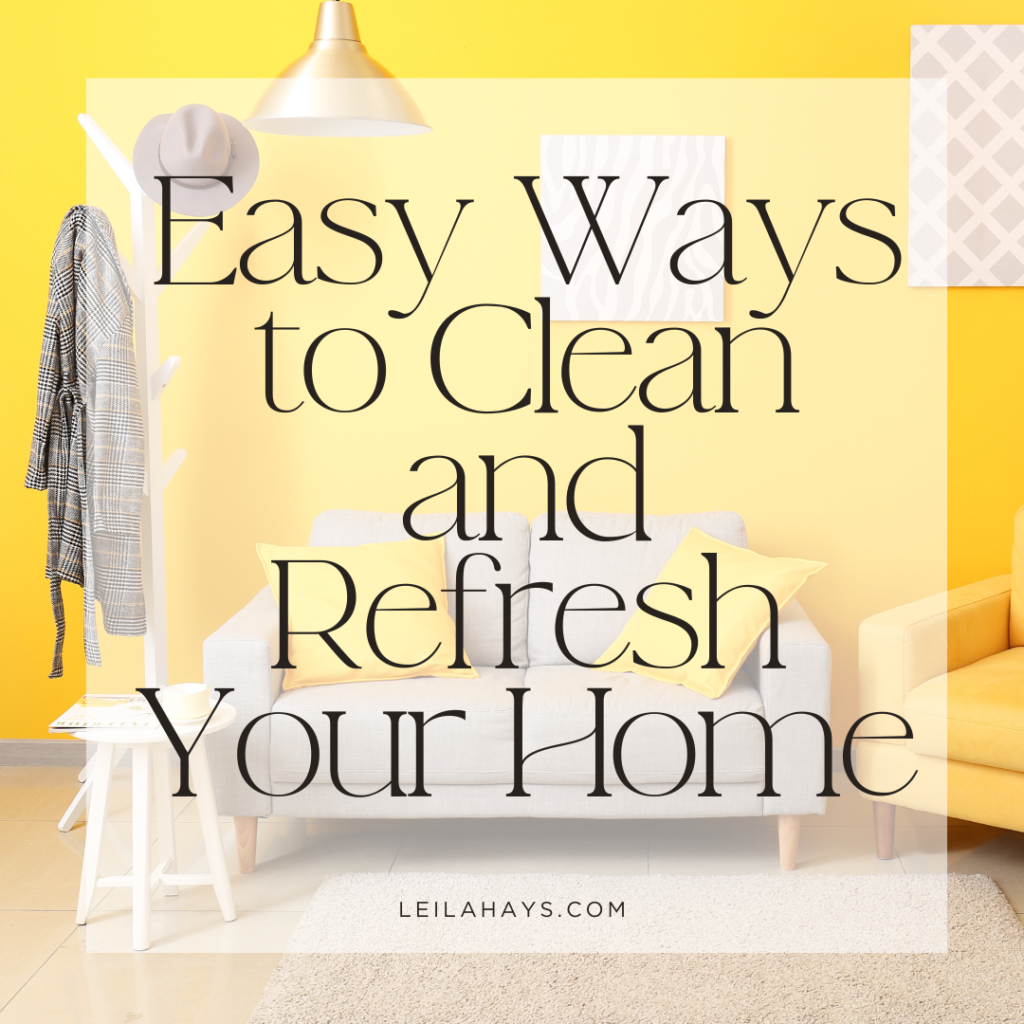Now more than ever, our homes need to be a sanctuary — a place where we feel safe, refreshed, and joyful. My 4-week series, How to Create a Happy and Healthy Home Inside and Out, is here to help you do just that! You’ll learn simple steps to boost your home’s health, functionality, and freshness — with easy, affordable ideas that can have a big impact.

First up: let’s talk about making your home a healthier place to live.
You already know that eating well and exercising are essential for staying healthy. But have you ever thought about whether your home is supporting your health, too?
We spend a big chunk of our lives indoors, and that’s why it matters. An unhealthy home environment can contribute to issues like asthma, allergies, headaches, fatigue, developmental problems — and in some cases, even increase the risk of more serious conditions over time.
The good news? Every homeowner can take simple, smart steps to make their home a healthier space. It doesn’t have to be complicated or expensive — it starts with knowing what to look out for and what easy changes you can make.
Here are some tips to get you started:
Banish Dust Bunnies
Dust does more than just sit there — it can carry contaminants that trigger allergies and worsen asthma and respiratory issues.
Dust particles are a mix of shed skin cells, pet dander, soil, fibers, and pollen. Plus, dust attracts mold spores and dust mites — those microscopic pests that thrive on dead skin cells. (Yep, it’s kind of gross!)
What to do:
- Vacuum regularly with a HEPA filter vacuum. Focus on carpets, drapes, blinds, upholstery, and air vents.
- Dust with damp cloths or electrostatic dust mops to avoid stirring dust into the air. Microfiber cloths work great too!
- Keep your bedroom clean. Use allergen-proof covers for your mattress and box spring, and wash bedding weekly in hot water. Memory foam mattresses naturally resist dust mites.
- Manage humidity levels (aim for 40–50%) with a dehumidifier to keep dust mites and mold at bay.
- Declutter! Less stuff = fewer places for dust, insects, and allergens to hide.
- Sanitize kids’ toys regularly — and pop stuffed animals in the freezer for 24 hours to kill dust mites.
- Replace carpet with hard flooring if possible.
- Clean air ducts if you have mold, insects, or rodents — otherwise, it might not be necessary.
- Leave shoes at the door! You’d be surprised what you track inside: dirt, pollen, even chemicals.
Let the Fresh Air In
Modern homes are energy-efficient, which is great — but they’re also tightly sealed, which means indoor pollutants can build up fast. Indoor air quality is often worse than outdoor air!
What to do:
- Open your windows when weather and air quality allow. Fresh air circulation helps clear out indoor pollutants.
- Replace air filters in your furnace/AC regularly — ideally every 2–3 months.
- Use a portable air purifier with a HEPA filter for key areas like bedrooms or offices.
- Consider a whole-house air filtration system for serious upgrades.
- Add houseplants! They’re natural air purifiers. Great choices include peace lilies, Boston ferns, snake plants, and dracaenas.
Check Product Labels for Toxins
Common household products can release harmful chemicals into your home’s air and dust. From sofas to shower curtains, it’s worth knowing what you’re bringing inside.
The good news: healthier options are easier to find than ever.
What to do:
- Choose solid natural wood furniture over engineered wood, which often emits formaldehyde.
- Stick to natural fibers like cotton, linen, and wool for furnishings.
- Avoid furniture with flame retardants. Look for labels added after 2015 to see if your sofa has them.
- Let new furniture and flooring “off-gas” outside or in a garage before bringing it in.
- Pick soy-based candles and essential oil diffusers over petroleum-based scented candles.
- Use chemical-free cleaning products — look for the EPA’s “Safer Choice” label or DIY your own!
- Toss old Teflon pans and switch to stainless steel or cast iron.
- Choose fragrance-free products to avoid hidden chemicals like phthalates.
- Watch out for lead paint if you live in an older home, and opt for low- or zero-VOC paints.
Dilute Any Moisture or Water Issues
Water can either keep your home healthy — or create major problems. Mold, mildew, and poor water quality can all impact your family’s health.
What to do:
- Control moisture! Vent bathrooms, attics, and basements properly. Use exhaust fans, dehumidifiers, and check for roof leaks.
- Clean up mold and mildew immediately. Hire a professional for large or stubborn issues.
- Fix any leaky pipes or water damage quickly before it gets worse.
- Test your tap water quality. Contact your local agency for reports and learn about any issues like lead pipes.
- Install a water filtration system or use a carbon filter pitcher to remove contaminants from your drinking water.
I hope you found these tips helpful! Even a few small changes can make a big difference in creating a healthier, happier home for you and your family.
Hi, there!
I'm Leila Hays, and I'm on a mission to help you buy and sell at the same time without paying two mortgages or moving twice. If you're planning to make a move in the next year, it's not too early to plan. Click the link below to get started.
Contact
832-402-6040
9303 New Trails Dr. Ste. 165
The Woodlands, TX 77381
leila@leilahays.com
what you need to know about buying or building
Homes You Might Love
(my listings)
what you need to know about owning or selling
All Articles
schedule your free consultation